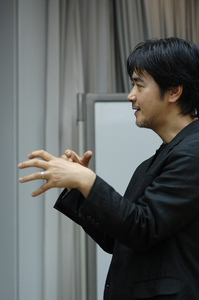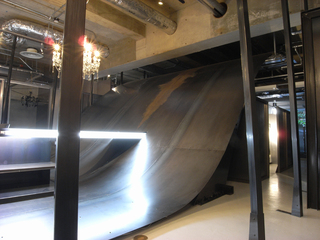Creative Café featured Architecture series No 1 'Stainable Beauty' 2/2
2010.09.29
GridFrame, the unfinished lattice
 Tanaka:from this the idea of Grid Frame emerged. Certainly, if before our very eyes chaos and disorder spread, we wouldn't accept it. Thus, if we say we should counter this, one technique to address this directly would be to cover the chaos with order via a lattice or Grid. Due to the covering Grid, we can create a surface of what we could call 'stainable beauty'. I thought let's create the parts of such a lattice system, and create every space, so I formed a company.
Tanaka:from this the idea of Grid Frame emerged. Certainly, if before our very eyes chaos and disorder spread, we wouldn't accept it. Thus, if we say we should counter this, one technique to address this directly would be to cover the chaos with order via a lattice or Grid. Due to the covering Grid, we can create a surface of what we could call 'stainable beauty'. I thought let's create the parts of such a lattice system, and create every space, so I formed a company.
Tsuda:did you establish this as a product?
Tanaka:yes. However, at the beginning it was just the parts to address the confusion. There aren't really any people who want to address confusion directly. To sell a product, it's necessary to let such a concept hide behind selling something which has an easy to understand and user-friendly design. The idea of Grid Frame is not just that of disorder, but to create a lattice which allows anything to be incorporated in a versatile way. However, to respond to the complicated process in dealing with the fixtures in the entire shop space, it was not sufficient just to have system parts. Therefore I extracted the important concept of the Grid Frame, and shifted to an approach where I didn't have to use system parts. Grid Frame is now the concept. The important part of this concept is 'to become'. If we do this, even though 'become' embodies Nature such as 'stainable beauty', there is the question whether we can realise this in the middle of present realities (do) and actions (create).
The current production process emerged from my attempt to answer this question.
I haven't established a precise goal. The meaning is still not complete. My company is implementing design; thus it is just a place where I am surrounded by people who can make things, and where we can create products relevant to shop fittings.
The design plan involves supplying a ground plan and path, but I don't draw the path in detail. You may say that there is a feeling of emptiness there, but it expresses just that. In regard to detail, there are four artists. When we show the client the path, we point out that "it will become this type of ambience but what finally is included we don't yet know" and that "some good things will emerge because that is our way of doing things". In reality we really proceed on the basis of trust. Therefore when I go to see what we have actually produced, I am also sometimes surprised and say to myself 'so that's what it's become'! (Laughter)
 For the artist designers to convey the feeling of space, we use the path and one phrase. This is our apparel showroom! In the showroom, on the other side of this undulating metal plate is the President's room where each day's bag design is made. There is this phrase "imagination penetrates like a flash of light from the cage to the stage". Next is the skeleton, this phrase is "the structural beauty from bone and muscle".
For the artist designers to convey the feeling of space, we use the path and one phrase. This is our apparel showroom! In the showroom, on the other side of this undulating metal plate is the President's room where each day's bag design is made. There is this phrase "imagination penetrates like a flash of light from the cage to the stage". Next is the skeleton, this phrase is "the structural beauty from bone and muscle".
On this basic design produced of the shop, we have the hope that we can then adjust gradually, as far as we can to change it towards the owner's preference. This is what we call the chain of our 'monodukuri' or manufacturing.
Among the things we have produced up to now, perhaps everyone will feel that the first objective which has been established may be a space facing disorder!
Practising creative salvage
 N: I think the Barcelona apartment building and the mountain of scrap etc. are interesting and I can see the attraction, but these were created from history by many people and are without name. This is now interesting but once was scary. But such a thing, entrusting everything to not just one designer but to artists, without setting the goal, is Grid Frame really creating such a stance?
N: I think the Barcelona apartment building and the mountain of scrap etc. are interesting and I can see the attraction, but these were created from history by many people and are without name. This is now interesting but once was scary. But such a thing, entrusting everything to not just one designer but to artists, without setting the goal, is Grid Frame really creating such a stance?
Q:There are many parts in the overall flow and tone which reflect my thinking too, I believe. I produced television programmes and series "a mountain of garbage is a mountain of treasure", which has been produced around five times! (Laughter) What we thought at that time was these things are not garbage, and if you do not look at the thing as a thing, you can't get anything started. Thinking in this way, we started to look at things not as rubbish but as things.
R: In places which are now called ruins, originally there was fantastic wealth; for instance where there was a large hotel, or mine, these things have now become unused. In such places for instance perhaps grass is growing, various weathering has taken place, and perhaps new values have appeared. At places which have now fallen apart, new values can once again emerge. It can be seen with a fresh eye.
Tsuda:there is the philosophy of creative salvage. This can be translated to "creatively recycling of waste goods" but is also the thought of creatively re-moulding waste goods. In Tanaka's way of thinking, creative salvage has already taken place and is realised in the product. Is this not just the elimination of disorder but a daring challenge to the accepted present era?

